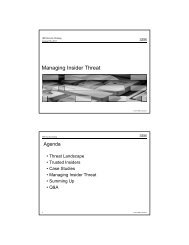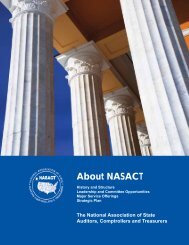Advisory Committee on Tax Exempt and Government Entities (ACT ...
Advisory Committee on Tax Exempt and Government Entities (ACT ...
Advisory Committee on Tax Exempt and Government Entities (ACT ...
You also want an ePaper? Increase the reach of your titles
YUMPU automatically turns print PDFs into web optimized ePapers that Google loves.
Improving the Employee Plans Compliance Resoluti<strong>on</strong> System: A Roadmap For Greater Complianceexcessive <strong>and</strong> will bear a reas<strong>on</strong>able relati<strong>on</strong>ship to the nature, extent <strong>and</strong> severity ofthe Plan Failure, based <strong>on</strong> a set of vague factors susceptible to wide interpretati<strong>on</strong>. 91Given the fact that the sancti<strong>on</strong> is a “negotiated percentage of the Maximum PaymentAmount,” the starting point for the negotiati<strong>on</strong> has the potential for being high <strong>and</strong> therange of appropriate sancti<strong>on</strong> amounts has the potential for being enormous. For large<strong>and</strong> small plans alike, the Maximum Payment Amount can reach into the milli<strong>on</strong>s ofdollars. Although specialists generally do not begin the negotiati<strong>on</strong> process at theMaximum Payment Amount, nevertheless, the specialists can exercise a great deal ofdiscreti<strong>on</strong> in formulating an initial dem<strong>and</strong> <strong>and</strong> a final settlement offer. 92 Moreover, in allbut the largest cases, decisi<strong>on</strong>s are made by relatively low grade-level Serviceemployees. Some practiti<strong>on</strong>ers who cannot reach agreement with the specialist mayinformally c<strong>on</strong>tact TE/GE leadership in an attempt to resolve the case. The <strong>ACT</strong> viewsthis step as problematic both for the practiti<strong>on</strong>er <strong>and</strong> the Service’s senior leadershipsince it could give rise to a claim of uneven treatment. Ultimately, most Plan Sp<strong>on</strong>sorsaccept the Service’s final settlement offer.Sec<strong>on</strong>d, Audit CAP is closed. Specifically, there is no public informati<strong>on</strong> as to thedispositi<strong>on</strong> of cases. While the specialists, the Group Manager <strong>and</strong> the CAPCoordinator have access to data revealing the range of sancti<strong>on</strong> amounts imposed incomparable cases, the Plan Sp<strong>on</strong>sor has no such access. Thus, the Plan Sp<strong>on</strong>sor is ata disadvantage in crafting a reas<strong>on</strong>able proposal <strong>and</strong> determining whether the Service’sdem<strong>and</strong>s are appropriate.Third, a Plan Sp<strong>on</strong>sor who cannot arrive at a settlement under Audit CAP has nomeaningful right of appeal. In the event a Plan Sp<strong>on</strong>sor is unable to reach anagreement with the Service, the Service issues a letter disqualifying the plan. The letterincludes a reminder that the Plan Sp<strong>on</strong>sor has 30 days to file an administrative appealwith the Service Appeals Office, an independent divisi<strong>on</strong> under the authority of theOffice of Chief Counsel. At Appeals, substantive issues are reviewed, but decisi<strong>on</strong>s tosettle are generally based <strong>on</strong> an assessment of the hazards of litigati<strong>on</strong>. 93 If the casecannot be resolved at Appeals, the Sp<strong>on</strong>sor has the right to appeal to the <strong>Tax</strong> Court.Unfortunately, this appeal procedure is of little use to most Plan Sp<strong>on</strong>sors. Because ofplan disqualificati<strong>on</strong>’s Drac<strong>on</strong>ian c<strong>on</strong>sequences to Plan Sp<strong>on</strong>sors <strong>and</strong> Participants alike,<strong>and</strong> the fact that a disqualifying event usually has occurred, most Plan Sp<strong>on</strong>sors areunwilling to risk an appeal <strong>and</strong> subsequent litigati<strong>on</strong> even if the Plan Sp<strong>on</strong>sor believesthe Service’s positi<strong>on</strong> is unwarranted. Thus, Plan Sp<strong>on</strong>sors who have negotiated to thebest of their ability with the specialist often feel that they are forced to accept inequitablyhigh sancti<strong>on</strong> amounts.91 Manual § 7.2.2.6.4. 92 The <strong>ACT</strong> c<strong>on</strong>sidered recommending a more objective system as a replacement to the existing <strong>on</strong>e modeled after the federal criminal sentencing guidelines, but rejected this approach as too restrictive. This view seemed to be shared by the EP leadershipbecause of the inherently complicated set of facts routinely presented in plan Failure cases.93 Oshinsky, “Employee Plans: Guidelines for the Resoluti<strong>on</strong> of Qualificati<strong>on</strong> Violati<strong>on</strong>s,” 20 <strong>Tax</strong> Management Compensati<strong>on</strong>Planning Journal 167, 175–176 (8/7/92); see also Wagner <strong>and</strong> Bianchi 375 T.M., EPCRS – Plan Correcti<strong>on</strong> <strong>and</strong> Disqualificati<strong>on</strong> atA–9.ADVISORY COMMITTEE ON TAX EXEMPT AND GOVERNMENT ENTITIES (<strong>ACT</strong>) June 11, 2008 40













